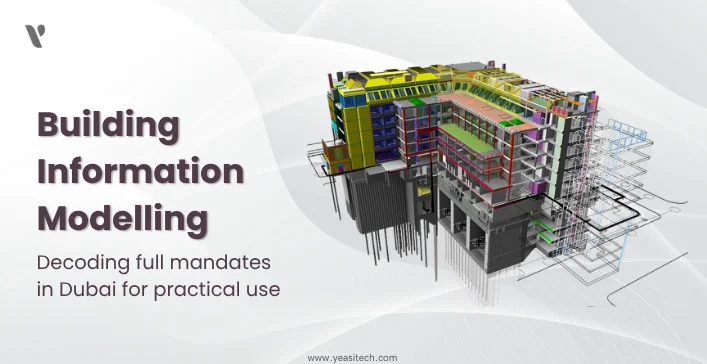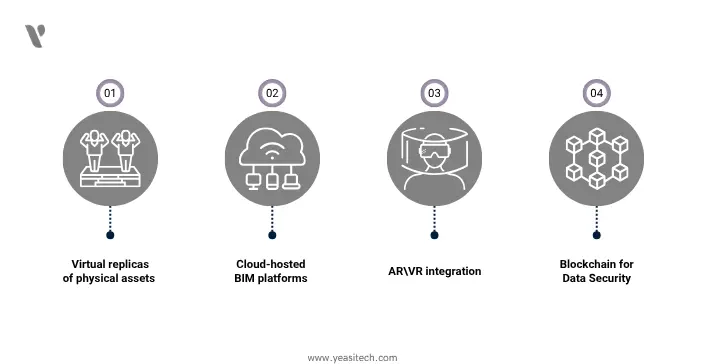Top Software Compliance Checklist for Dubai BIM Mandate 2025

Imagine having the ability to move around a building before any bricks are placed. You can test the water systems, change the lighting, view the wiring, and even model how much energy is being used. Sounds like the future? It’s already a reality in Dubai—thanks to Building Information Modeling (BIM).
As of 2025, Dubai mandates BIM usage for large-scale projects, making it not just a best practice but a regulatory necessity. This blog unpacks the why, what, and how of Dubai’s BIM mandate, offering a beginner-friendly, practical guide with real-world tools, insights, and checklists to help professionals and newcomers alike thrive in this digital construction era.
Building Information Modeling is like the Google Maps of a building—but way more detailed. It creates a 3D digital twin of a structure with data-rich layers that include architecture, engineering, plumbing, electricity, and much more.
| Benefit | Impact |
| Visualization | See the building in 3D before it’s built |
| Clash Detection | Prevent costly errors before construction begins |
| Cost & Time Savings | Reduces waste, rework, and delays |
| Sustainability | Optimize energy use and environmental impact |
| Lifecycle Management | Streamlines facility maintenance post-construction |
With Building Information Modeling, we moved from 2D drawings to a multidimensional platform that redefines construction management.” – Dr. Mohammed Al Muhairi, UAE Ministry of Infrastructure Development
Dubai’s commitment to smart urban growth is deeply tied to Building Information Modeling adoption. Let’s decode the legal and policy structure:
Dubai Municipality Circular 196 (2014) initiated the Building Information Modeling journey, but by 2025, the guidelines will be more defined:
Mandatory Building Information Modeling Usage:
Submission Requirements:
Other UAE entities have embraced Building Information Modeling:
Fun Fact: The UAE was one of the first countries in the MENA region to issue a government-level BIM directive.
Selecting the right Building Information Modeling software is crucial for compliance and efficiency. Here’s an analysis of popular Building Information Modeling tools suitable for the UAE market:




Pro Tip: Ensure your chosen software supports ISO 19650, the international BIM standard increasingly favored by UAE municipalities.
Let’s tackle the elephant in the room—is Building Information Modeling worth the cost?
| Item | Estimated Cost |
| Software Licenses | $1,800–$5,000/year/user |
| Training & Upskilling | $300–$1,500 per employee |
| Hardware Upgrades | $1,200–$3,000 per workstation |
| Consultant/Implementation | $10,000–$50,000 (project-based) |
Stats: According to McKinsey, BIM-led projects are 30% more likely to stay within budget compared to traditional 2D workflows.

Building Information Modeling is evolving rapidly. Here’s what’s shaping its future in 2025:
Fun Fact: Dubai aims to be the world’s first blockchain-powered city by 2030—BIM will be a key contributor!
To comply with Building Information Modeling regulations, certification isn’t optional—it’s strategic:
| Certification | Body | Benefit |
| Autodesk Certified Professional | Autodesk | Validates software expertise |
| buildingSMART Professional | buildingSMART Int’l | Global standard |
| RICS Building Information Modeling Manager | RICS UK | Management-level credential |
“Upskilling teams in BIM is not an expense—it’s an investment in competitiveness.” – Ahmed Al Suwaidi, Construction Tech Lead, Abu Dhabi Municipality
Now that Building Information Modeling is the norm, how do you stay ahead?
Fun Fact: Dubai Municipality is piloting AI-based BIM review systems to reduce manual code checks by 50%.

Whether you’re an architect, a contractor, or a real estate investor, 2025 is the year Building Information Modeling becomes your passport to progress in Dubai. Don’t wait for an RFP to force your hand—take the lead now.
👉 Need help selecting software, getting certified, or building a BEP? Let’s talk. Your trusted BIM compliance partner in the UAE.
Let’s not just build taller—let’s build smarter.
The Dubai BIM Mandate 2025 is a government directive requiring Building Information Modeling (BIM) usage for specific public and large-scale construction projects to enhance efficiency, transparency, and lifecycle management in the AEC industry.
All stakeholders involved in Dubai Municipality-approved projects—such as architects, engineers, contractors, and consultants—must comply if their project meets the mandate’s criteria (e.g., size, type, or public funding).
Compliant BIM software must support open data formats like IFC, align with ISO 19650 standards, and enable collaboration, coordination, and lifecycle data management. Examples include Autodesk Revit, Bentley OpenBuildings, and Trimble Tekla
The mandate references ISO 19650, PAS 1192, and UAE-specific regulations that define BIM execution plans, data deliverables, and collaboration protocols for digital construction workflows.
Non-compliance may lead to delayed approvals, rejections of design submissions, or penalties. Adhering to the checklist ensures smoother approval workflows with Dubai Municipality and better project outcomes.
Currently, it is mandatory for certain public and large-scale developments. However, private sector adoption is rapidly increasing due to long-term cost savings, regulatory alignment, and competitive advantage.
YeasiTech is a trusted IT service partner with 8+ years of experience, empowering 250+ businesses with scalable web, mobile and AI solutions.
Explore related topics to broaden your understanding and gain actionable insights that can transform your strategies.